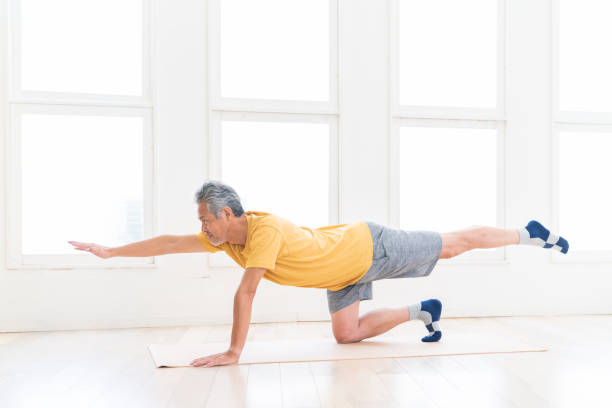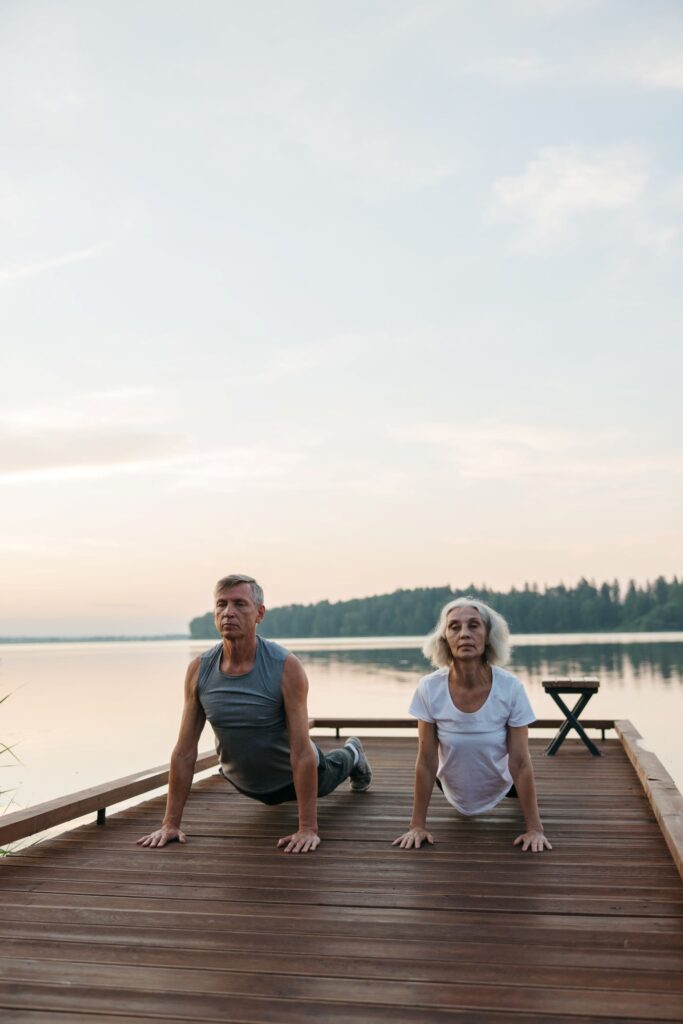Fitness
Exercise Tips For Seniors
Regular physical activity is essential for seniors since it provides several benefits to their overall health. Exercise helps seniors maintain their strength, flexibility, and balance, lowering the risk of falls and keeping them independent for longer. It also boosts cognitive performance, lowers the risk of chronic illnesses including diabetes and heart disease, and improves mood and mental health. However, it is critical to select workouts that are both safe and appropriate for seniors’ unique requirements and abilities.
Seniors should contact with their doctors before beginning any new exercise regimen, especially if they have any pre-existing medical concerns. Once they obtain the go-ahead, individuals can reap the benefits of exercise and improve their quality of life.
Benefits of exercise for seniors
Exercise has numerous benefits for seniors. Physical activity can boost cardiovascular health, lower blood pressure, and lower the risk of heart disease. It aids healthy weight management and improved sleep quality. Regular exercise also improves cognitive function, namely memory and attention span.
Furthermore, exercise benefits both the body and the mind. It can alleviate symptoms of despair and anxiety, raise self-esteem, and improve general happiness. Physical activity also allows for social connection, which is beneficial to seniors’ mental and emotional health.

Common concerns for seniors when exercising
Seniors may have worries about exercising, such as fear of injury, lack of energy, or decreased mobility. These issues can be addressed by selecting exercises suitable for their age and fitness level. It’s critical to start slow and progressively increase the intensity and length over time.
Another prevalent issue is the risk of joint pain or discomfort. Low-impact exercises, such as walking, swimming, or cycling, are ideal for seniors since they place less strain on their joints. It’s also crucial to listen to your body and adjust activities as needed to avoid discomfort or suffering.
Types of exercises suitable for seniors
There are a variety of workouts that are safe and appropriate for elders. These workouts can be simply included into their everyday regimen and have several health benefits. Here are few examples:
Low-impact cardio routines.
Low-impact cardio workouts are easy on the joints while still giving an effective cardiovascular workout. Walking is an excellent choice for seniors because it can be done anywhere, at any time. It is critical to begin with lesser distances and progressively increase the length and intensity of the walks.
Swimming and water aerobics are both good options for seniors. The water provides resistance, making these workouts good for muscle strength and cardiovascular conditioning. Furthermore, swimming is low-impact, which reduces the danger of damage.

Strength training exercises
Strength training activities help to preserve muscular mass and bone density, which can decrease with age. Seniors can strength train using resistance bands, dumbbells, or even their own body weight. Squats, lunges, bicep curls, and tricep dips can be done at home or in the gym.
It’s critical to begin with lesser weights and progressively increase the resistance as strength grows. Seniors should practice good form and technique to avoid injury. If you are unsure how to execute specific exercises, consulting with a skilled trainer or physical therapist can provide direction and assure safety.
Balance and flexibility exercises
Maintaining balance and flexibility is critical for elders to avoid falling and maintain independence. Standing on one leg, walking heel-to-toe, and practicing yoga can all help you improve your balance and flexibility. These exercises can be done at home or in a group setting, like a yoga or tai chi class.
Stretching and other flexibility exercises can assist improve range of motion and reduce muscle stiffness. Warm up before stretching, and do it gradually, without bouncing or jerking.
Tips for starting an exercise routine
Starting an exercise regimen might be difficult, but with the appropriate mindset, it can become a rewarding habit. Here are some suggestions to help elders get started:
- Set realistic goals: Begin with simple, manageable goals and progressively increase the intensity and duration of your workouts. Celebrate each milestone achieved along the way.
- Find activities you enjoy: Select exercises you enjoy doing. This will make it easy to follow the regimen and stay motivated.
- Make it a habit: Make exercise a habit by scheduling regular sessions and prioritizing them. Consistency is crucial to getting the advantages of exercise.
- Start slowly: Start with shorter workouts and lower intensities, especially if you’re new to exercising or haven’t been active in a while. Allow your body to adjust while progressively increasing the difficulty.
- Listen to your body: Pay close attention to how your body feels during and after exercise. If something does not feel right or causes pain, adjust or discontinue the exercise. Listen to your body’s instincts and avoid pushing too hard.

Safety precautions for seniors during exercise
Safety should always be the number one consideration when exercising, especially for elders. Here are some crucial safety precautions to consider:
- check with a healthcare provider: Before beginning any new exercise program, seniors should check with their physician, especially if they have any pre-existing medical ailments or concerns.
- Warm-up and cool-down: Always start with a warm-up to get the muscles and joints ready for exercise. This might be as basic as walking in place or gently stretching. Similarly, each exercise session should conclude with a cool-down to gradually drop the pulse rate and stretch the muscles.
- Stay hydrated: Drink plenty of water before, during, and after exercise to ensure optimum hydration.
- Use appropriate footwear and clothing: Wear comfortable, supportive shoes that give stability and lower the chance of falling. Wear breathable, moisture-wicking clothing to stay cool and comfortable when exercising.
- Take breaks as needed: If you feel tired or out of breath, take stops and relax as needed. Listen to your body and avoid overexertion.
- Modify exercises: If an exercise is too difficult or causes discomfort, adjust it to fit your ability. There are frequently alternative exercises or variants that can be used to get similar results.
Incorporating balance and flexibility exercises
Maintaining balance and flexibility becomes more vital as we age. Here are some exercises to assist improve these areas:
- Standing on one leg: If necessary, get assistance from a wall or other substantial object. Lift one leg off the ground, bend the knee, and hold for a few seconds. Repeat with the opposite leg. This exercise promotes balance and stability.
- Heel-to-toe walk: Take short strides with the heel of one foot directly in front of the toes of the other. Walk in a straight path while maintaining balance. This workout improves balance and coordination.
- Yoga: Take a yoga session or watch online videos made specifically for elders. Yoga poses promote flexibility, balance, and strength. It’s critical to select a class or video that is appropriate for your fitness level and capabilities.

Exercises for strength and endurance
Strength and endurance activities are essential for preserving muscle mass and general fitness. The following exercises can assist seniors increase their strength and endurance:
- Squats: Stand with your feet shoulder-width apart, bend your knees, and lower yourself as if sitting back in a chair. Keep your back straight and your chest lifted. Return to the upright posture and repeat. Squats assist to strengthen the muscles in the lower body, particularly the quadriceps and glutes.
- Bicep curls: Hold dumbbells or resistance bands in both hands, palms facing front. Bend your elbows and bring the weights to your shoulders. Slowly lower the weights and repeat. Bicep curls serve to develop the muscles in the upper arms.
- Wall push-ups: Stand facing a wall with your hands at shoulder height. Slowly bend your elbows, putting your chest close to the wall, then push back to the beginning position. Wall push-ups strengthen the chest, shoulders, and arms.
Tips for staying motivated and consistent
Maintaining motivation and consistency with a fitness regimen can be difficult, but it is critical for long-term success. Here are some suggestions to help seniors keep on track.
- Find a workout buddy: Exercising with a friend or family member can enhance the experience and provide accountability.
- Vary your routine: Mix up your exercises to keep things fresh. To avoid boredom, try new activities or participate in group sessions.
- Set rewards: Provide little incentives for attaining objectives or sticking to your fitness plan. This can provide extra motivation to stay dedicated.
- Keep track of your progress: Keep track of your exercise, noting any increases in strength, endurance, or flexibility. Seeing improvement can be quite motivating.
- Celebrate accomplishments: Recognize every success, no matter how minor. Recognize the effort you’re doing for your health and well-being.
Conclusion
As a senior committed to maintaining my well-being, I understand the importance of incorporating regular exercise into my routine. Exercise is a cornerstone for preserving my strength, flexibility, and balance, providing a multitude of physical and mental health benefits that contribute to a fulfilling and active lifestyle. These advantages range from improved cardiovascular health to a reduced risk of chronic diseases and enhanced mood.
Prior to embarking on any new exercise program, I make it a point to consult with my healthcare provider, ensuring that the chosen activities align with my health needs. Throughout the process, I remain attuned to my body’s signals, starting slowly, setting achievable goals, and maintaining consistency. By dedicating myself to the right exercises, I aim to stay fit, healthy, and independent for years to come.


